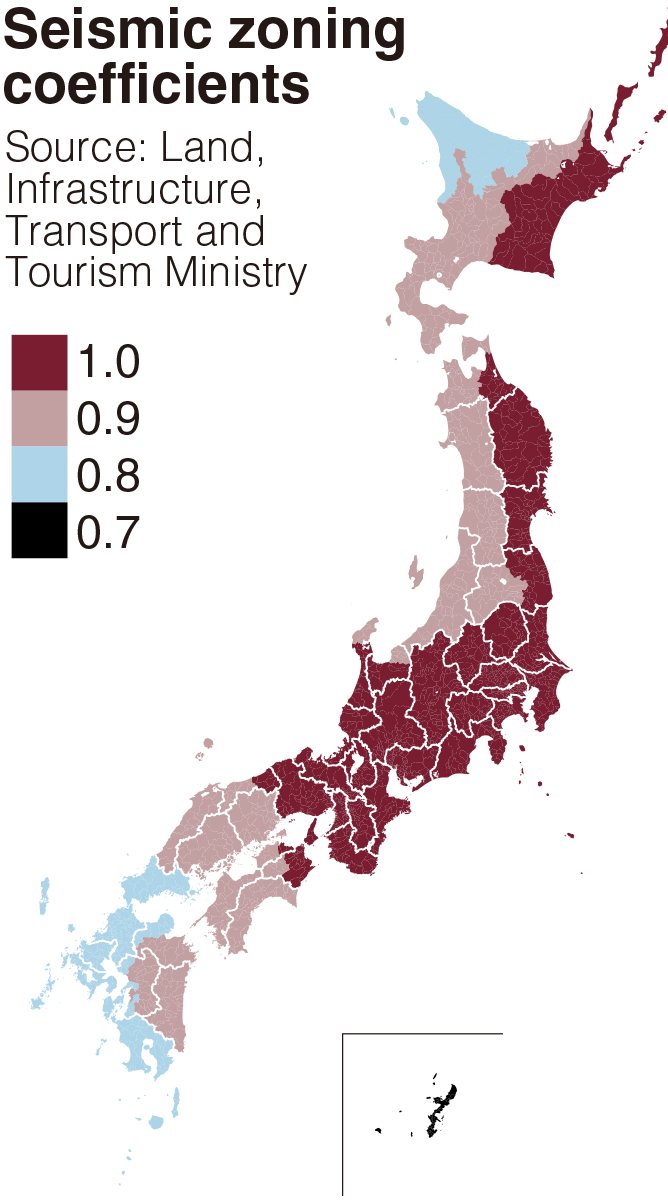Japan Eyes to Review Seismic Standards for Buildings; Could Make Strength Requirements Uniform across Nation

6:00 JST, March 23, 2024
The government is considering revising seismic resistance requirements for buildings following the Noto Peninsula Earthquake, it has been learned. The standards currently vary from region to region.
The Land, Infrastructure, Transport and Tourism Ministry envisions making the standards uniform throughout the country after a series of large-scale earthquakes that have hit the Noto region in Ishikawa Prefecture, Kumamoto Prefecture and other areas where seismic resistance is allowed to be below general standards.
Seismic resistance standards are based on the principle that buildings should be strong enough to withstand an earthquake of upper 6 or 7 on the Japanese seismic intensity scale of 7.
However, some regions are allowed relaxed standards for reinforced concrete buildings and wooden buildings of three or more stories, which both require structural calculations.
The Building Standards Law requires that the risk be assessed for each region and that seismic resistance be multiplied by the seismic zoning coefficient, which is specified by the ministry. The coefficients ranges from 1 to 0.7 based on records, the frequency of earthquakes, and the extent of expected damage. The current figures were issued in 1980.
The coefficient for Tokyo and Osaka, which are at significant risk of damage from earthquakes, is set at 1.
The coefficient is set to 0.9 in areas that have seen a quake of 7 on the seismic intensity scale, such as the 2016 Kumamoto Earthquake and the 2018 eastern Iburi earthquake in Hokkaido. This allows the strength of buildings to be reduced by 10% in structural calculations, which generally results in lower construction costs.
Since damage in the two earthquakes was mainly to wooden houses of two stories or less, the government did not revise the coefficient, believing that its effect was limited.
However, since the coefficient is also 0.9 in areas hit by the Noto Peninsula quake in January, which registered a 7 on the seismic intensity scale, the ministry has decided to launch a comprehensive review of the system that allows regional differences.
An expert committee plans to analyze the relationship between seismic resistance and damage by surveying damage to reinforced concrete buildings in Ishikawa Prefecture. It will then formulate a policy by this fall.
If the coefficient is set to 1 for all regions, the government will apply the revised standard to buildings constructed after the revision.
Buildings constructed prior to the revision will not be considered in violation of the law, and will not need to be reinforced after the change.
"Politics" POPULAR ARTICLE
-

Japan to Support Central Asian Logistics Route That Bypasses Russia, Plan to Be Part of Upcoming Summit in Tokyo
-

Japan to Tighten Screening of Foreigners’ Residential Status by Providing Information of Nonpayment of Taxes
-

Chinese, Russian Bombers Flew Unusual Path by Heading Toward Tokyo; Move Likely Meant to Intimidate Japan
-

Japan Plans National Database to Track Foreign Ownership of Real Estate, Land as It Weighs New Rules
-

Up to 199,000 Deaths Estimated From Mega-Tsunami; Most Recent Occurrence Took Place in 17th Century
JN ACCESS RANKING
-

Tokyo Economic Security Forum to Hold Inaugural Meeting Amid Tense Global Environment
-

Keidanren Chairman Yoshinobu Tsutsui Visits Kashiwazaki-Kariwa Nuclear Power Plant; Inspects New Emergency Safety System
-

Imports of Rare Earths from China Facing Delays, May Be Caused by Deterioration of Japan-China Relations
-

University of Tokyo Professor Discusses Japanese Economic Security in Interview Ahead of Forum
-

Japan Pulls out of Vietnam Nuclear Project, Complicating Hanoi’s Power Plans























